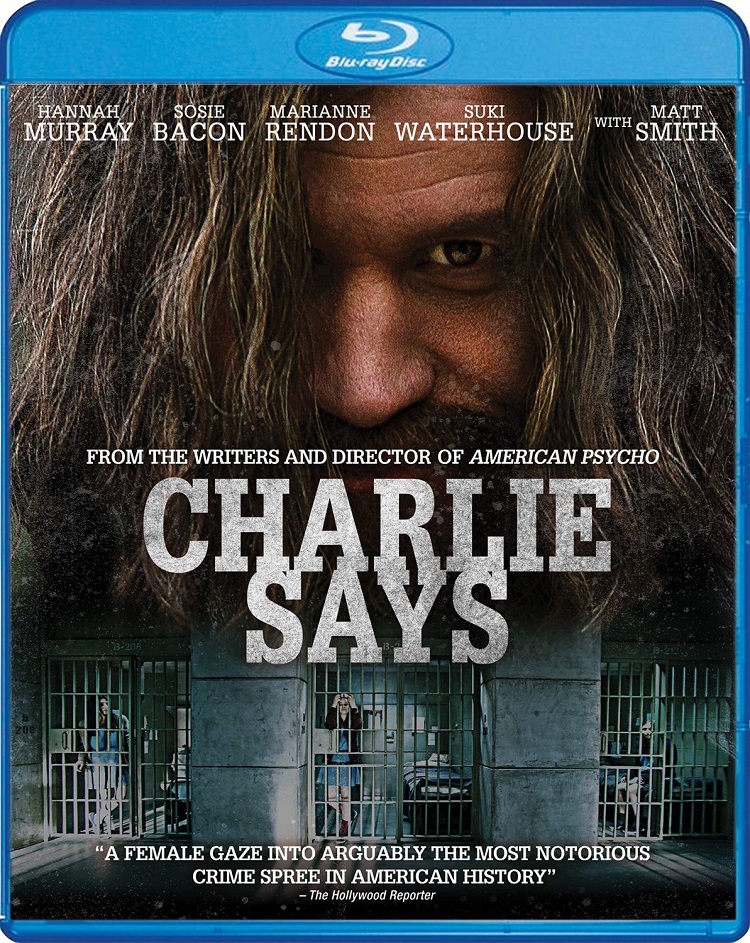
This take on the Manson family and the gruesome 1969 murders of Sharon Tate, Rosemary and Leo LaBianca, and others focuses on the young women who committed the murders, not cult leader Manson. Traditionally, the Manson girls are portrayed as brainless, bloodthirsty robots programmed by Charlie, without much backstory. Charlie Says explores the process that turned the girls from confused runaways to murderers.
The male characters (except for Manson) aren’t given much camera time. Matt Smith portrays Manson as a charmastic manipulator weaving his way into the girls’ psyches, as he coerces them into doing his biding. The girls are isolated on the Spahn Ranch, and Manson vacillates between flattering, seducing, and berating the girls. The effect seems to be so subtle that it’s shocking to hear him when he does fly into a rage
The film is tied together by the counseling sessions Van Houten, Krenwinkel, and Atkins received in prison. Karlene Faith, the founder of the Santa Cruz Women’s Prison Project, conducted women’s studies sessions with the girls in 1972. The screenplay is based on her book The Long Prison Journey of Leslie Van Houten as well as Ed Sanders’ book The Family. It takes awhile, but after several meetings, light seeps through cracks in the girls’ chaotic exteriors.
It’s harrowing for the viewer to realize that the girls now understand what they’ve done as the counseling sessions clear up the fog Manson brought upon them. The film doesn’t paint the girls as victims. One of the girls is presented with a chance to escape from the compound (with Charlie’s blessing). Will her response be prompted by free will or fear? After being brainwashed by Charlie for so long, dose she even have free will?
The performances may be a little too subtle for some viewers, as there’s no of the frothing at the mouth overacting, even during the Sharon Tate murder scene. We don’t see much of the blood and gore aftermath in Charlie Says, just the girls executing the murders sans close-ups. All the performances seem restrained, given the subject matter, but Manson’s brainwashing techniques are slow and calculated, but punctuated with rage.
Screenwriter Guinevere Turner was actually born into a cult. Her mother was a teenage member of the Lyman Family Cult. The Lyman Cult employed the same social isolation and LSD-soaked rhetoric of the Manson Family. Turner’s first-hand experience gives the film an authenticity that addresses the sense of, well, a real “family” the girls got from Charlie, but also the isolation and danger spawned by a lack of freedom. They had no idea of the extent of Charlie’s “Helter-Skelter” until they were totally under his control.
Hannah Murray (Game of Thrones) stars as Van Houten, Sosie Bacon (13 Reasons Why) as Krenwinkel, and Marianne Rendon (Mapplethorpe) as Susan Atkins form the crux of the gang, but we see brief appearances by Squeaky Fromme, Mary Brunner, and Linda Kasabian.
Director Mary Harron (American Psycho) films many of the scenes in an all-consuming darkness. The darkness signals more than the sinister nature of Charlie and the crimes to come, but also the emotional walls closing in on the remnants of the girls’ pre-Charlie personalities.
Charlie Says doesn’t direct the viewer to any particular conclusion, but simply focuses on the road that lead the young women to Manson and the horrific crimes, with a hint at what may come later. Harron and Turner offer a different perspective on the factors that led to one of the most infamous crimes of the 20th Century.